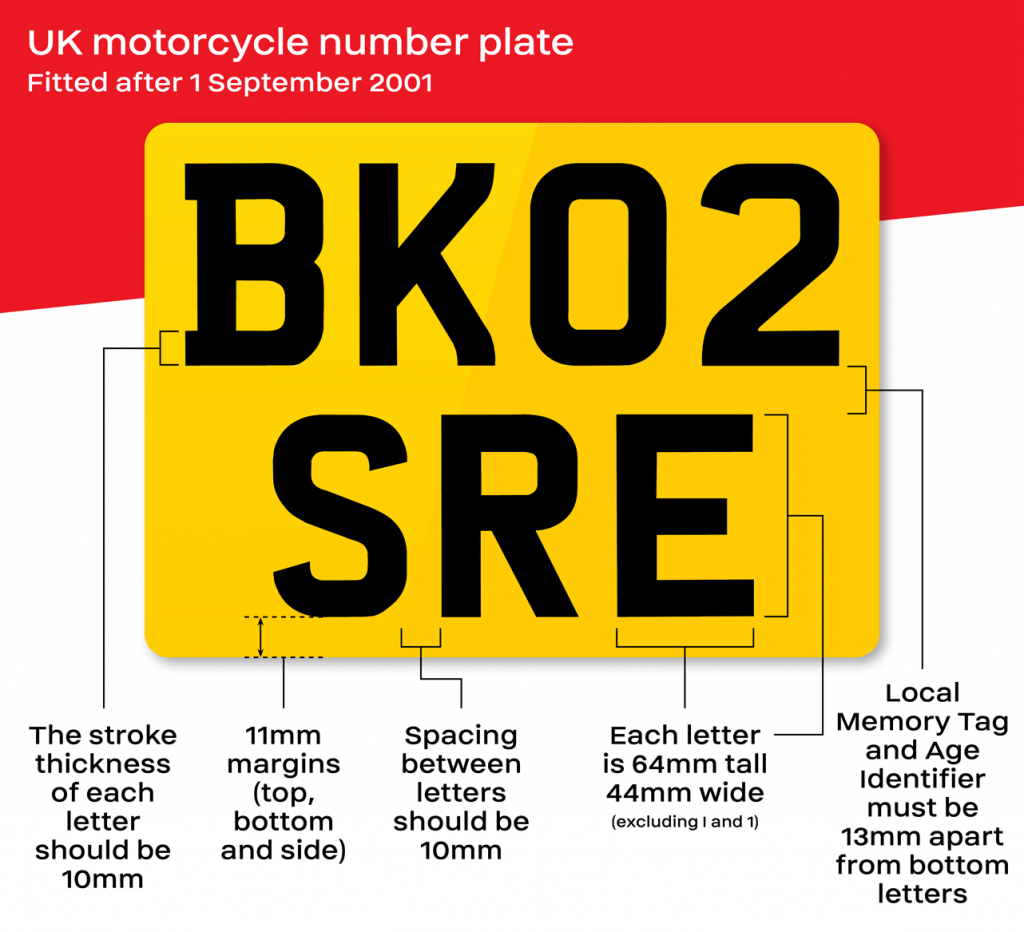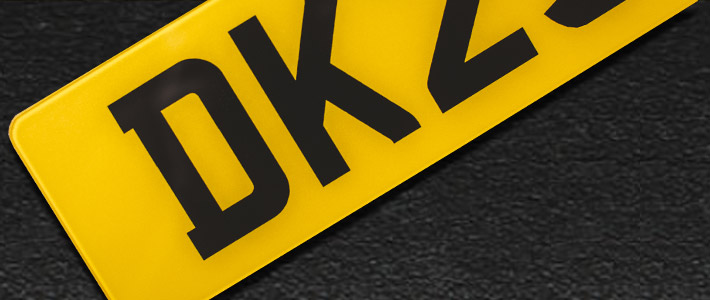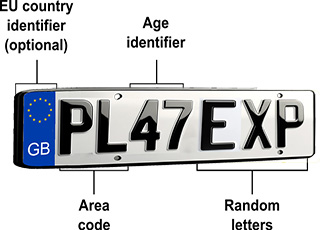
Number plates play a pivotal role in the functioning of the UK road network. They serve as a unique identifier for vehicles, aiding law enforcement, facilitating vehicle registration, and contributing to road safety.
Behind their apparent simplicity are many rules and regulations governing their design, construction, and display. This article delves into the rules and regulations of number plates in the UK, highlighting their significance and outlining the various requirements that motorists must adhere to.
General Requirements for Number Plates
In the UK, the Driver and Vehicle Licensing Agency (DVLA) subjects number plates to general specifications that ensure their readability, uniformity, and durability. These requirements encompass various aspects, including materials and construction, size and dimensions, and visibility and illumination.
Materials and Construction
Number plates must be easily legible from a distance and in various lighting conditions. To achieve this, they are constructed using reflective materials. This reflective property ensures that number plates remain readable, even when illuminated by headlights or streetlights.
Uniformity is crucial in avoiding confusion. The DVLA authorised a standardised font to ensure consistency across all number plates, reducing the chances of misinterpretation or error in identifying vehicles.
Number plates encounter various environmental conditions. As a result, they need to be constructed from weather-resistant materials that can withstand these challenges without deteriorating. Using durable materials ensures that number plates maintain their integrity and legibility over time.
Size and Dimensions
In the UK, both front and rear number plates have standardised dimensions. This standardisation allows law enforcement, automated systems, and other road users to quickly and accurately identify vehicles based on their number plates.
The dimensions of characters and the spacing between them are carefully regulated to prevent confusion and maintain readability. Characters on number plates must adhere to the 79mm height and 50mm width requirements, ensuring drivers can easily recognise them from a distance.
Number plates must be aligned and positioned correctly on the vehicle to maximise visibility and identification. Adhering to proper alignment and positioning guidelines ensures that number plates are visible and easily readable.
Visibility and Illumination
Adequate lighting is essential to ensure that the characters on the plate are illuminated and easily visible, even in low-light conditions. This requirement enhances road safety by enabling accurate vehicle identification during nighttime travel.
Regulations prohibit the use of reflective or tinted coverings on number plates. These coverings can disrupt the reflective properties of the plate or reduce the contrast between characters and background, leading to decreased readability.

Characters and Formatting
The DVLA meticulously regulates the characters and formatting of number plates in the UK, covering aspects such as font, colour, size, spacing, and special characters.
Font and Styling
The choice of font is pivotal in ensuring easy recognition and uniformity. The standard font type for UK number plates is ‘Charles Wright’ or the ‘Block’ typeface.
To maintain maximum contrast and legibility, strict guidelines regulate the colour of characters that can be used on number plates. Number plates must use black characters. For backgrounds, front plates must use white and rear plates must use yellow. Patterns are also prohibited.
This combination of colours ensures that characters stand out clearly against the light background, making them easily readable.
Special Characters and Symbols
While number plates seem like an opportunity for creativity, regulations restrict using non-alphanumeric characters. This limitation is in place to prevent confusion and ensure that the primary purpose of clear vehicle identification is not compromised. The DVLA permits only letters and numbers on number plates.
Content and Information
The content displayed on a number plate goes beyond mere letters and numbers. The regulations governing the content and information on number plates ensure accuracy, clarity, and the prevention of misleading or inappropriate messages.
Registration Mark
The DVLA issues the vehicle’s registration mark to identify the car uniquely. The regulations mandate the precise and accurate display of this registration mark on the number plate.
You cannot alter the characters using different fonts, sizes, or styles, because doing so can undermine the primary purpose of clear identification. By prohibiting such alterations, the regulations ensure that registration marks are uniform and easily interpretable.
The distinction between letters and numbers is another crucial aspect of number plates. To prevent confusion between characters that may resemble each other, such as the letter ‘B’ and the number ‘8,’ the regulations require a clear differentiation.
Supplier Information
Every number plate must display the registration number of the supplying manufacturer. This information provides a traceable link between the vehicle and its manufacturer, contributing to accountability and transparency.
Number plates must display the British Standard mark to ensure compliance with quality standards. Cars fitted before 1 September 2021 must display ‘BS AU 145d’ on the plate, while those fitted after must show ‘BS AU 145e.’ This mark signifies that the number plate manufacturer has met specific materials, construction, and durability criteria.
Personalised Plates
Personalised plates may have unique combinations of letters and numbers, but they are not exempt from adhering to size, font, and spacing regulations. This compliance ensures that number plates remain clear and easily readable even with personalisation.
While personalised plates offer a creative outlet, there are limits to what can be displayed. The regulations strictly prohibit using offensive, inappropriate, or misleading content on number plates.
Replacement and Maintenance
Maintaining a standard-abiding number plate is as equally critical as acquiring one. If you ever need to replace your current number plate or get a temporary plate, here are some things to know.
Damaged or Illegible Plates
Several reasons warrant the replacement of number plates. These include visible damage such as cracks or breakage, fading that renders characters unreadable, and wear that compromises the plate’s legibility. Additionally, if a number plate no longer complies with formatting, font, or other regulations, it must be replaced to adhere to legal standards.
Temporary Plates
Temporary plates, often used for vehicles that are in transit, undergoing repairs, or being test-driven, are subject to specific regulations. These plates are designed to be quick solutions and have their own set of rules. Trade plates used by those in the motor trade for unregistered vehicles also have specific guidelines.
Temporary plates have a limited validity duration, and trade plates are issued for specific purposes and timeframes. Correctly displaying these plates is essential to ensure the correct vehicle identification and usage of the temporary or trade plate within its intended timeframe. Failure to follow these guidelines can result in legal consequences.
Enforcement and Penalties
The enforcement of number plate regulations involves fines, penalties, and potential legal actions. Depending on the severity of the violation and its impact on road safety and identification, the consequences can range from hefty fines to penalties, such as the suspension of vehicle registration. In cases of repeated or intentional non-compliance, authorities may pursue legal actions.
Special Cases and Exemptions
In recognising the diversity of vehicles on UK roads, number plate regulations also account for particular cases and exemptions. These provisions acknowledge the unique circumstances of certain vehicles, such as vintage or historic vehicles and vehicles destined for international markets.
Vintage and Historic Vehicles
Vintage and historic vehicles carry a charm that transcends time, and regulations acknowledge this by offering certain concessions. Often preserved as a testament to automotive history, these vehicles may be exempt from adhering to some modern statutes. However, they must still maintain clear identification while respecting their historical integrity.
In many cases, vintage and historic vehicles can retain their original-style number plates, enhancing their authenticity and historical accuracy. This provision celebrates the character and heritage of these vehicles while ensuring they remain identifiable on the road.
Exported Vehicles
The regulations include rules for number plates on vehicles that are bound for international markets. These plates, specifically designed for temporary use during transit, enable vehicles to be legally driven to ports of departure or foreign destinations. In addition to export plates, specific documentation and other requirements help ensure the lawful transfer of vehicles across borders.
Exported vehicles must adhere to international standards to ensure safe and legal operation in foreign countries, including compliance with the host country’s number plate regulations. This adherence ensures that vehicles maintain their identification and contribute to road safety even in unfamiliar environments.
The Takeaway
These regulations, meticulously designed to ensure uniformity, legibility, and accountability, play a critical role in the functioning of the UK road network. By adhering to these regulations, motorists contribute to a safer, more efficient road environment.
Clear identification is at the heart of road safety. In emergencies, quick and accurate identification of vehicles is essential for timely and effective responses. Number plates are the first line of identification, and adhering to regulations ensures that this marker remains accurate and legible, thus enhancing road safety for everyone on the road.
If you want more updates regarding number plate rules and regulations in the UK, Plates Express offers extensive guidance. We also provide personalised and legally binding number plates with a same-day delivery option.
Contact us today or use our number plate maker and see the Plates Express difference.



